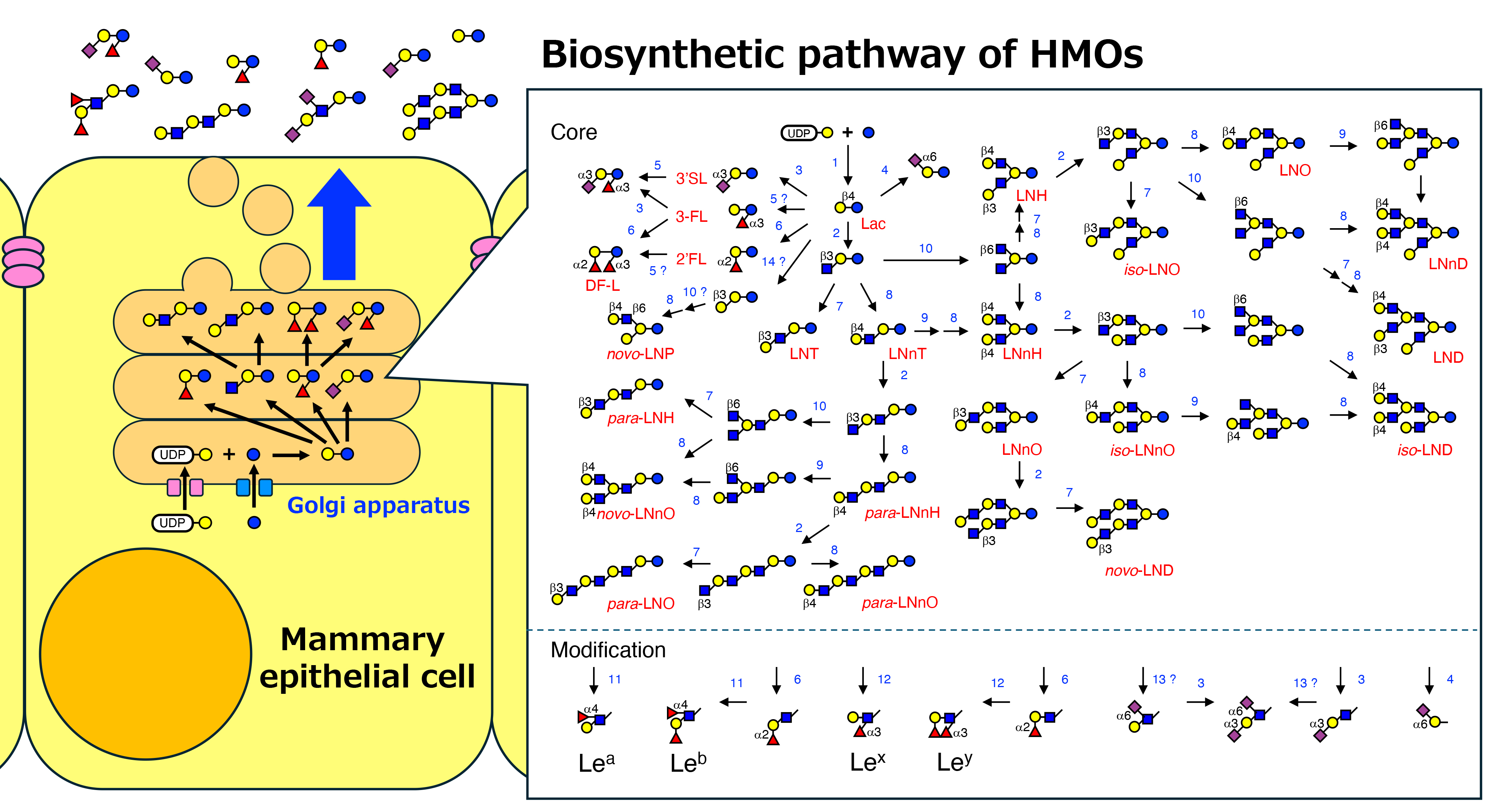Our Rsearch Field

Humans are composed of tens of trillions of cells, and the cell surfaces are covered with glycans. Glycans are one of the four major biopolymers along with nucleic acids (DNA, RNA), proteins, and lipids, and are sometimes called as “the third life chain”.
Glycans exist alone or as glycoconjugates bound to proteins and lipids. Glycans modify proteins and contribute to the protein folding, intracellular transport, stability, and activity. Glycans on the cell surface are used for communication with other cells or as markers that indicate who the cell is. On the other hand, some viruses, bacteria, and toxins utilize glycans present on the cell surface for infection or entering the cells. In addition, glycan structures are changed in tumors, contributing to the growth and exacerbation of cancer cells.
Therefore, glycans are important factors in terms of quality control and function in the production of biopharmaceutical glycoproteins such as antibody drugs. In addition, the development of therapeutic drugs and diagnostic markers targeting diseases such as cancer and infectious diseases is underway. During promoting the identification and functional analysis of factors involved in the biosynthesis and transport of glycans and glycoproteins, we are trying to contribute to the above fields.
Research topics
1. Biosynthesis and intracellular transport of glycoproteins

One of our target glycoproteins is the GPI-anchored protein. On the cell surface, a group of proteins are modified with a glycolipid called glycosylphosphatidylinositol (GPI). GPI-anchoring of proteins is a widely conserved post-translational modification in eukaryotes from yeast and protozoa to insects, plants and mammals. In humans, more than 150 kinds of proteins such as receptors, cell adhesion factors, hydrolases, and prion proteins exist as GPI-anchored proteins. Our previous research has revealed that GPI is a functional molecule that not only anchors proteins to the cell surface, but also controls intracellular trafficking and localization of the modified proteins (Fujita et al. (2006) Mol. Biol. Cell; Fujita et al. (2009) Cell; Fujita et al. (2011) J. Cell Biol.; Liu et al. (2018) J. Cell Biol., etc.). We are currently studying the genes and proteins involved in the biosynthesis and intracellular transport of GPI-anchored proteins. In addition to GPI-anchored proteins, we are analyzing special glycoproteins, which do not use typical secretory pathways (ER-Golgi-Plasma membrane), and try to elucidate how the special glycoproteins are transported and what molecules are necessary for them.
 Go to the top
Go to the top
2. Development of visualization tools for glycan metabolic pathways and glycan prediction

Knowing what kinds of glycans are synthesized in the cells/tissues of interest is important information not only for glycol-engineering, but also for understanding the properties of the cells/tissues. Currently, glycan structural analysis is mainly performed using mass spectrometry and liquid chromatography, but the analysis of glycans with large molecular weights, charged glycans, and glycans with isomers requires skilled techniques. We have developed a tool "GlycoMaple" that visualizes the glycan metabolic pathways in the target cell from gene expression profiles and estimates the glycan structures that can be synthesized (Huang et al. (2021) Dev. Cell). We believe that this tool will not only assist glycan structural analysis, but also contribute to the analysis of glycol-engineering, regulatory mechanisms of glycans, and disease marker development. We are currently working on improving the GlycoMaple.
We are constructing cell libraries in which glycan-related genes are knocked out based on information from GlycoMaple (Huang et al. (2021) Dev. Cell; Liu et al. (2021) Commun. Biol.). Using these as basic research resources, we are trying to establish host cells suitable for producing biopharmaceutical glycoproteins (Jin et al. (2018) J. Biol. Chem., etc.).
Go to the top3. Elucidation of the biosynthesis and functions of human milk oligosaccharides

Human Milk Oligosaccharides (HMOs) are a group of oligosaccharides naturally present in breast milk. In colostrum (the first milk produced by humans), HMOs are found at approximately 20 g/L, while mature milk contains 12–13 g/L of HMOs. These compounds constitute the third most abundant solid component in breast milk, following lactose and lipids. HMOs are known to have various beneficial effects, including: shaping and maintaining the gut microbiota in breastfed infants, antimicrobial properties, anti-inflammatory effects, nutritional enhancement, brain development. In recent years, research has suggested that HMOs may also be beneficial for adults, contributing to immune activation, gut health improvement, and brain function.
The synthesis of HMOs occurs within the mammary epithelial cells, where they are subsequently secreted. However, many aspects of the HMO biosynthesis pathway remain unclear. Our team, building upon the GlycoMaple project, is focusing on identifying and characterizing the entire group of glycan-related enzymes involved in HMO synthesis. Additionally, we are exploring attempts to reconstruct HMO synthesis within cultured cells. Furthermore, we aim to elucidate the specific roles of individual HMOs using cell and animal models. Understanding HMOs and their functions contributes not only to infant health but also to potential benefits for adults.


